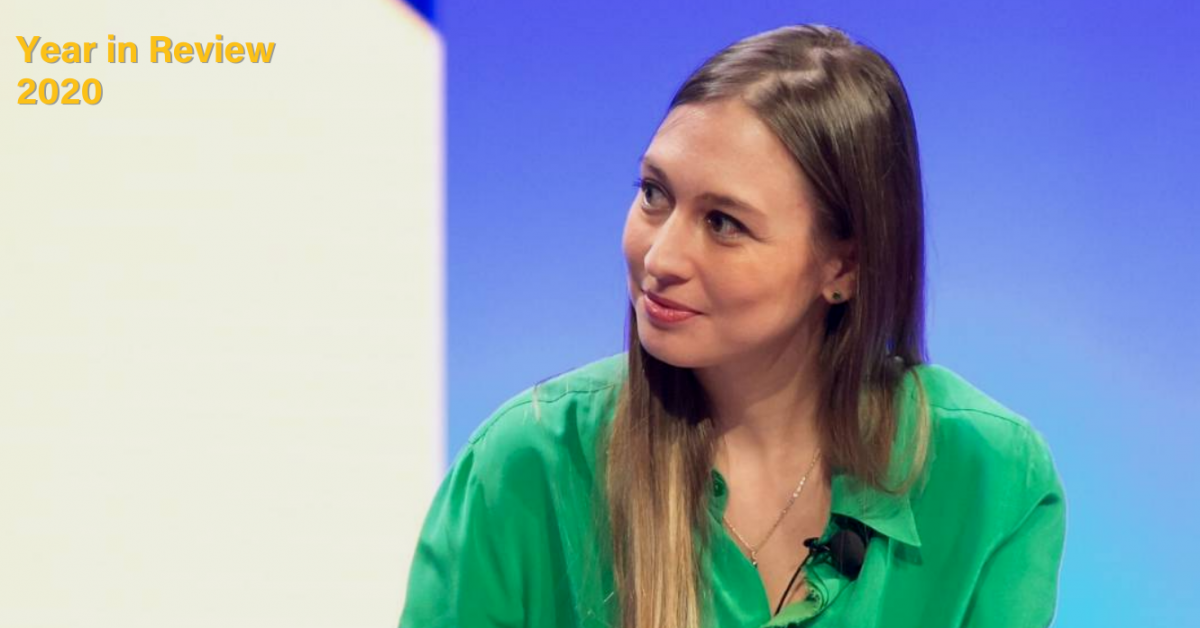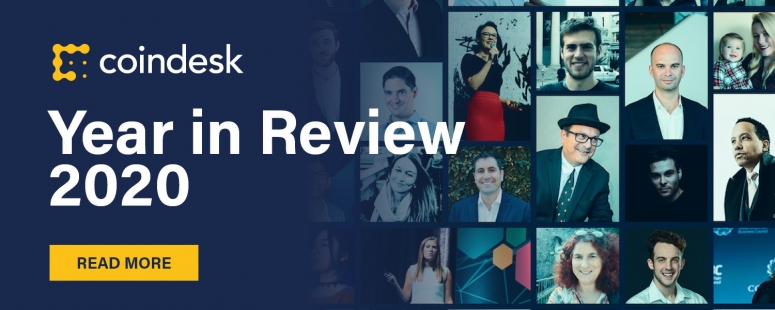Talk about good timing: In 2017, Camila Russo was on the prowl for a worthy book project. What would be a good subject? What hasn’t been covered?
At the time she was a reporter for Bloomberg. She was astonished to find a juggernaut of a story that was hiding in plain sight: Ethereum. “I was like, ‘I can’t believe that nobody is covering this,’” she says now. There were already crates of books written on Bitcoin, but there were very few, if any, on the world’s second-largest blockchain project.
This post is part of CryptoX’s 2020 Year in Review – a collection of op-eds, essays and interviews about the year in crypto and beyond.
So she hunkered down. She did the research, she dove deep into the community, she turned herself into an expert and she wrote “The Infinite Machine: How an Army of Crypto-hackers Is Building the Next Internet With Ethereum.” The book just so happened to have a publication date of July 14, 2020, smack in the middle of the explosive boom of decentralized finance (DeFi – still largely an Ethereum-based phenomenon).
Many book authors – lazier book authors (I count myself in this company) – would have simply thanked their good luck for the happy timing, soaked in the extra publicity, sold more books, perhaps taken a long vacation and then move on to the next book project.
Russo took a different path. While still finishing up her book, she realized that she had a unique perspective on the exploding world of DeFi. Suddenly she was an expert in the very thing that people were hungry to read. So she spent her days knocking out book edits and then her nights writing and launching her daily newsletter, The Defiant.
Fast forward one year. In a lightning-fast arc even by the standards of crypto, Russo has made the jump from reporter to influencer (even if she doesn’t use that word), and from book author to CEO. She hosts videos and podcasts. She headlines blockchain conferences – listed here, for example, just a handful of spots behind Vitalik Buterin and a few spots ahead of Binance Chairman CZ. “I’ve never been good at taking breaks,” she tells CryptoX, giving us the behind-the-scenes story on launching The Defiant, sharing what it’s like to go from journalist to budding crypto star and making a few predictions about DeFi in 2021 and beyond.
Interview has been condensed and lightly edited for clarity.
What were some early challenges of launching The Defiant?
Russo: In the early days, and until pretty recently, I was still writing my book. The final two chapters weren’t even written. And I had to go through all of the corrections, the back-and-forth with editors – you know how it is. I would write my book from 8 or 9:00 a.m. until 5, then I took an hour- or maybe a two-hour break, and then I wrote the next day’s newsletter until 11:00 p.m.
I’m exhausted just hearing that. What were your goals for The Defiant back then?
Russo: In the beginning, I thought it would be a side thing, and that my main job would be to become an independent freelance writer. That was my initial plan when I left Bloomberg. I started with the goal of writing a daily DeFi newsletter, but I didn’t think it would be that much work. I thought it would be just a “quick summary of the news.”
Russo: I found myself thinking that, well, I didn’t want to write something that was of bad quality. And I wanted to explain what was going on. DeFi is really difficult, so I wanted my newsletter to provide more explanation, more value and a little bit more analysis. So the issues started getting longer and longer and taking more effort and time. But I also saw The Defiant growing quickly and getting great feedback. So it was hard to stop.
I didn’t want to let people down. And I was having fun doing it, even though it was exhausting. I was like, Okay, I’m on to something here. Covering the space every day, it was so clear to me that this was going to be big, given the amount of innovation and activity. I thought, I need to stick to this.
When you started, what were some of your inspirations for the newsletter’s form or content or tone – that kind of thing?
Russo: The person who first encouraged me to do a newsletter was Anthony Pompliano. He interviewed me for his podcast and we began talking. I told him I had this idea of doing a DeFi newsletter. And he really encouraged me, he pointed me to Substack.
So I started following his newsletter much more closely as I was getting ready to launch The Defiant. I took a lot of inspiration from him on how he provides analysis on the market and how he has the free version and the paid version and how he has established a closer relationship with his paid subscribers.
Russo: For a long time I’ve subscribed to The Information. They’re doing a really great job with their newsletter. And they inspired me to realize that a newsletter can be high-quality journalism. You can have high standards, and it’s not necessarily like a personal blog all the time, you know?
100%. Since then, you’ve obviously grown a ton. What were some of the key inflection points?
Russo: It’s been pretty gradual, organic growth since the beginning. I was writing about different projects and people, and the people I was writing about started sharing. And I had some really good fans early on. Linda Xie from Scalar Capital has been super supportive, recommending the newsletter. A16z has a crypto resources guide, and The Defiant is included. So I started getting shout-outs from these big, respected investors in the space.
Also, your timing didn’t hurt.
Russo: The curve of subscribers shot up during “DeFi Summer.” It was really exciting. One thing I learned is that, yeah, my newsletter is still very much tied to the market.
See also: Camila Russo – Ethereum Is Building the Internet of Value
When did you start to expand The Defiant, in terms of adding resources and writers?
Russo: The first step was realizing that people were willing to pay for the content. Late last year, I started taking paid subscriptions and it was just incredible to see that people were subscribing. It’s weird because at first, I was scared to kind of be on my own. I always had the Bloomberg brand to back me up.
And suddenly you’re just you.
Russo: And people were still wanting to pay for that, so that was incredible to see. [Laughs.] And then earlier this year, I was getting requests to sponsor the newsletter. At that point I decided to take sponsors and it started to feel more like a business. And I just didn’t have the time to do it all on my own, so it made sense to take on contributors. I reached out to a couple of writers I liked, and that’s how it started.
What’s your pool of contributors like now?
Russo: Cooper Turley is the writer who’s writing most frequently, and I have four others who write every couple of weeks or so. There’s someone [Robin Schmidt] who helps me edit the podcast. And I partner with someone to make the YouTube content.
Do you have a biz-dev person? Who does things like, ‘Okay, now I’m going to optimize sponsorships?”
Russo: No. So far, that’s kind of been my job to manage all of the different sponsors and handle all of those inbound emails and stuff. It’s been really interesting. All of my previous experience was as a journalist, but now I’m still that, plus sort of a CEO – overseeing a team of almost 10 people. And I’m managing all these decisions with sponsors, pricing and the newsletter. It’s been fun.
It seems like there’s an interesting parallel here, to the many folks in the crypto space who started as coders or devs or whatever and then they’re like, “Holy s**t, now I’m the head of a $20 million project!” Do you feel any new kinship with the heads of these crypto startups?
Russo: Definitely. I can definitely put myself in the founder’s shoes a lot better now. For example, when I’m covering something that goes wrong, I can be a lot more empathetic. Like, I know how it is. You have so much on your plate, and you’re trying to control so many different things at the same time. As a startup, it’s all on you. You’re handling everything.
When did it hit you that you’ve gone from being someone who reports on the space to someone who can actually have an influence on the space?
Russo: I’m not sure of the exact story or the date, but I remember seeing some smaller crypto web sites report on these things that I had said, or something I had tweeted. That was pretty weird. I didn’t expect it. I was like, “That had never happened at Bloomberg.” Because when you’re at Bloomberg, you’re one more Bloomberg journalist. It started to sink in that people were citing me by my name. Before I was a “former Bloomberg journalist,” and now I’m either “The author of ‘The Infinite Machine” or “The founder of The Defiant.”
I’m fascinated by how you keep all the balls spinning in the air. Can you walk through your typical day?
Russo: This has been changing throughout the year, but right now the first thing I do is edit stories that my contributors have sent me overnight. My main contributor, Cooper, just moved to the West Coast, so I get them at night and edit them in the early morning.
Russo: The first thing I do is take out my dog, who you’ve probably heard. [Note: Her dog, Conga, has been barking periodically throughout our conversation.] She’s our alarm clock and starts barking between 6:30 and 7:00 [a.m.]. I try to be sitting at my desk by 8 or 8:30 and then I start editing. I’m also writing stories.
How much of the newsletter do you still write?
Russo: Depending on the day, between 50% to 60%. And then the contributors in my time zone send me stories in the morning. I edit those. And while I’m juggling that I’m answering urgent emails. So I’m doing that all morning: editing, writing, answering urgent emails. Then I finally push out the newsletter between 1 p.m. and 2 p.m. One of my goals for next year is to standardize the process, and get the newsletter out every day at 8 a.m.
Russo: That’s where I schedule most of my calls. I’ll either record an interview for my podcast, or record something for the YouTube channel, or talk with potential sponsors, or talk with sources, or take calls on sponsorship, or do podcast interviews for other people’s podcasts. I’m trying to do less and less of those.
Well, I’m honored you took this call.
Russo: This was special. This was a special case. [Laughs again.]
Russo: I do work a little bit. I put out a weekly recap on Sundays. My goal is to have it scheduled on Friday, but I haven’t been able to organize myself to do that so I end up doing it, always, on Sunday morning. But recently I’ve had my Saturdays off.
What do you do for fun? I mean, to the extent that we can have fun in the pandemic?
Russo: My dog [Conga] is a big part of my life. My husband and I moved to Brooklyn [N.Y.] this year, and we got Conga just as the pandemic started. So on the weekends we take really long walks in Brooklyn, or we go to the park. Also I’m a big nerd and I love to read.
There will come a point where DeFi will seem like a really antiquated term, and that it’s just part of life
Cool, what are you reading now?
Russo: “The Mandibles” by Lionel Shriver, It’s really good. It’s not sci-fi but it’s set in 2029, and it’s all about how the U.S. has declined and the dollar is losing its power. But it seems very suitable for the bitcoiner audience. [Laughs.] And then I really loved “The Nix.” It’s this big story about a dysfunctional family and they bring a lot of Norwegian folk stories into it.
Predictions for DeFi in 2021?
Russo: For the general trend, obviously DeFi will continue growing. And for next year, the biggest pieces that still need to gain steam are under collateralized loans. So far, DeFi has been very much based on collateral, and I think that’s made adoption difficult. Or it’s made it a very niche thing because you need capital to start using it. So hopefully next year will be the year where under-collateralized loans start picking up. And I think the key to that will be different identity solutions, or decentralized credit cards. Those two developments will be key for DeFi to continue to grow.
How about in the next five years?
Russo: I think DeFi will continue to grow really quickly, and it’s bound to start merging, more and more, with fintech. Right now, fintech and DeFi are like two separate worlds. But that really makes no sense. I think the next step will be for companies to start building bridges between DeFi and fintech. And that will be the way that DeFi starts going mainstream and becoming just finance. There will come a point where “DeFi” will seem like a really antiquated term, and that it’s just part of life, sort of like finance – just how you deal with money.
It’s almost like the “De” in DeFi might become silent.
Russo: Definitely, yeah.
This has been fun. Thanks for playing ball.
Russo: I loved it, it was really fun.





